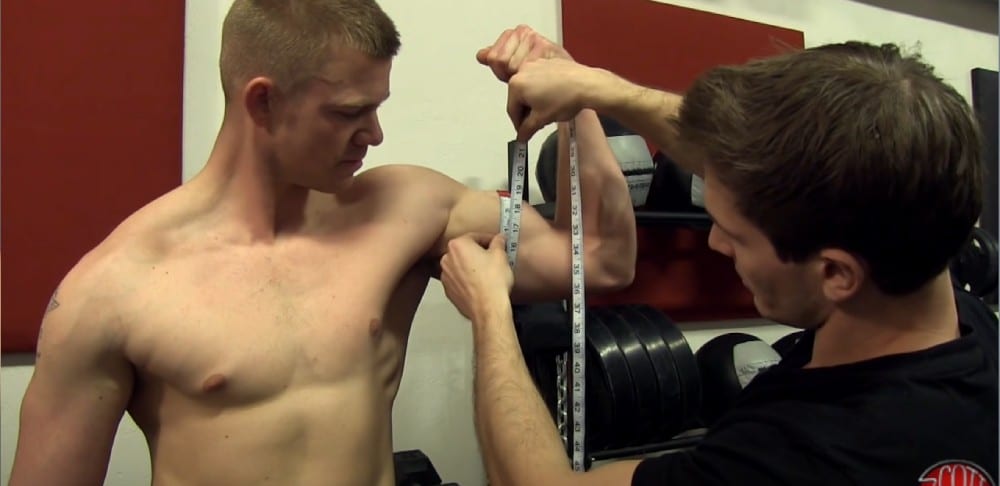Are you looking for signs that you’re gaining muscles and losing fat? Let’s look at reliable (and unreliable) ways to do so.
Also, discover why muscle growth isn’t just about bulking up and how fat loss transcends mere aesthetics. Learn to interpret the subtle yet profound signs of progress, from the fit of your clothes to the newfound ease in daily tasks. Understanding Muscle Gain and Fat Loss.
But first:
Jump to:
What is Muscle Gain?

Muscle gain, or hypertrophy, occurs when muscle fibers repair and grow thicker after being stressed through exercise, particularly resistance training. This growth is fueled by a combination of adequate protein intake and a calorie surplus.
Muscles become denser and stronger, but not necessarily larger in volume. This is why someone can gain more muscle, without seeing a dramatic change in their weight.
The Dynamics of Fat Loss

Fat loss, on the other hand, happens when the body burns more calories than it consumes to lose body fat. This calorie deficit can be achieved through diet, exercise, or a combination of both.
Unlike muscle gain, fat loss doesn’t necessarily improve strength or fitness levels. It’s more about reducing the body’s fat stores, leading to changes in body composition.
Signs of Muscle Gain
Increased Strength and Endurance
One of the most tangible signs of muscle gain is a noticeable improvement in strength and endurance. This isn’t just about hoisting heavier dumbbells or adding plates to the barbell. It’s about feeling a distinct ease in workouts that once pushed your limits.
Whether it’s increased resistance in your Crossfit WODs or powering through that extra mile with less fatigue, these improvements are clear indicators of muscle growth.
Physical Changes: More Than Meets the Eye
Muscle gain also manifests in visible changes. This isn’t always about bulging biceps or chiseled abs. It’s about noticing a firmer, more defined body shape. Muscles might not balloon in size, but their enhanced definition and the way your clothes fit differently speak volumes.
These changes are often gradual, so regular progress photos can be a great tool to track this transformation.
Improved Functional Performance
Gaining muscle transforms not just your workouts, but your daily life. Tasks that once felt strenuous, like carrying groceries or lifting weights or climbing stairs, become noticeably easier.
This improved functional performance is a testament to increased muscle strength and endurance.
What About Weight Changes?
Understanding weight changes in the context of muscle gain can be tricky. Muscle is denser than fat, meaning it takes up less space but weighs more. So, even as you build muscle and your body becomes leaner and more toned, the scale might show an increase in weight.
This is why relying solely on the scale can be misleading. Instead, focus on how you feel, how your clothes fit, and your overall health and fitness improvements.
Signs of Fat Loss
Changes in Body Measurements
Fat loss often manifests in subtle yet significant changes in body measurements. A reduction in waist size is a classic indicator, reflecting a decrease in visceral fat.
Clothes begin to fit differently, especially around areas prone to fat storage like the hips and abdomen.
Regularly measuring key body parts can provide concrete evidence of fat loss, even when other indicators seem ambiguous.
Improved Cardiovascular Health
Fat loss isn’t just about aesthetics; it’s intrinsically linked to improved cardiovascular health.
A lower resting heart rate and quicker recovery post-workout are telltale signs.
These improvements indicate a more efficient heart and circulatory system, often a direct result of reduced body fat.
Visible Physical Changes: Seeing is Believing
As fat diminishes, muscle tone becomes more defined, giving your body a leaner, more sculpted appearance.
This is particularly noticeable in areas where muscle and fat coexist, like the arms and legs.
While weight loss might be visible, it’s the enhanced muscle definition that truly showcases the loss of fat.
Scale Fluctuations
Again, as for weight gain, a change in weight is often a poor indicator of results, so I recommend using the previous signs instead.
Body Fat Tests – The Best Way to Measure Progress

Body fat testing is often considered one of the best ways to measure real progress in fitness and health for several compelling reasons (Source).
Unlike scales that measure total body weight, body fat tests specifically evaluate the proportion of fat in your body. This method provides a more comprehensive understanding of your fitness progress, especially when you’re aiming to gain muscle and lose fat.
Types of Body Fat Tests
- Skinfold Calipers: Measures the thickness of skinfolds at various body parts to estimate body fat percentage.
- Bioelectrical Impedance Analysis (BIA): Sends a weak electrical current through the body to estimate body fat percentage based on resistance to the current.
- Dual-Energy X-ray Absorptiometry (DEXA): A more precise method that uses X-ray technology.
- Hydrostatic Weighing: Known as underwater weighing, it compares your weight on land to your weight submerged in water.
- Air Displacement Plethysmography (Bod Pod): Measures body mass and volume to determine body density.
Body Fat Testing with Calipers: A Simple and Accessible Method
Body fat testing using skinfold calipers is a widely accessible and straightforward method for anyone looking to measure body composition changes. This technique estimates body fat percentage by measuring the thickness of skinfolds at specific locations on the body. Here’s how to effectively use calipers for body fat testing:
Preparation for Caliper Testing
- Purchase Quality Calipers: Invest in a reliable set of skinfold calipers for consistent measurements.
- Learn the Technique: Familiarize yourself with the proper technique for pinching and measuring skinfolds.
- No Special Requirements: Unlike other methods, caliper testing doesn’t require fasting or avoiding exercise beforehand.
Conducting the Test
- Identify Measurement Sites: Common sites include the triceps, subscapular area, abdomen, and thigh.
- Consistent Pinching Technique: Use your thumb and forefinger to gently pinch the skin and underlying fat away from the muscle.
- Take Measurements: Place the calipers about 1 cm away from your fingers, wait a few seconds for the calipers to settle, and then read the measurement.
- Repeat for Accuracy: Measure each site at least three times and use the average for more accurate results.
Interpreting Results
- Use a Body Fat Chart: Compare your measurements to a body fat percentage chart to understand your body fat level.
- Consistency Over Absolute Accuracy: Focus on changes over time rather than the exact percentage, as caliper readings can vary based on technique.
Limitations
- Technique-Sensitive: Accuracy depends heavily on the consistency of the measurement technique.
- Subject to Error: Can be less accurate than professional methods like DEXA scans.
Other Methods to Measure Progress

Tape Measurement
Tape measurements are a simple yet effective way to track muscle gains and fat loss. This method involves using a measuring tape to record the circumference of various body parts. It’s a practical approach for those who want to monitor their physical changes without relying solely on the scale. Here’s a step-by-step guide on how to do it:
Equipment Needed
- A flexible measuring tape (preferably made of fabric or plastic, not metal)
- A notebook or an app to record measurements
Preparation
- Consistency is Key: Always measure at the same time of day, preferably in the morning, as body measurements can fluctuate throughout the day.
- Wear Minimal Clothing: To get accurate measurements, wear tight-fitting clothing or measure directly on your skin.
- Relax Your Muscles: Avoid flexing during measurements to ensure consistency.
Measuring Process
- Neck: Measure around the smallest part of your neck.
- Shoulders: Measure around the widest part of your shoulders.
- Chest: Wrap the tape around your chest, just under your armpits and across the shoulder blades.
- Biceps: Measure around the fullest part of the bicep with your arm relaxed at your side.
- Waist: Measure at the narrowest point, typically just above the belly button.
- Hips: Measure around the widest part of your hips.
- Thighs: Measure around the fullest part of your thigh.
- Calves: Measure around the largest part of your calf.
Tips for Accuracy
- Maintain the Tape’s Position: Ensure the tape is level and not twisted.
- Don’t Pull Too Tight: The tape should be snug but not digging into your skin.
- Use a Mirror: This helps in ensuring the tape is positioned correctly.
- Repeat for Consistency: Measure each area at least twice to ensure accuracy. If there’s a significant difference, measure a third time.
Recording and Tracking
- Document Your Measurements: Write down each measurement. Include the date for tracking progress over time.
- Visual Progress: Consider taking photos in conjunction with tape measurements for a visual representation of your changes.
Interpreting Results
- Muscle Gains: Increases in areas like the chest, biceps, and thighs can indicate muscle growth.
- Fat Loss: Reductions in measurements, especially around the waist and hips, often suggest fat loss.
Limitations
Remember, tape measurements can be influenced by various factors like water retention and should be considered alongside other methods like body fat testing, strength assessments, and how your clothes fit.
Strength and Body Measurements
Merging strength metrics with body measurements offers a clearer insight into your progress.
For instance, if your strength is consistently increasing in lifts and your waist measurement is stable or decreasing, it’s a strong indication of muscle gain without significant fat accumulation. This method provides a practical and accessible way to track changes, especially for those without access to advanced testing facilities.
Progress Pictures
Progress photos are a powerful tool in your fitness arsenal. They offer visual evidence of changes that numbers alone can’t capture. By taking consistent photos under similar conditions (lighting, time of day, attire), you can visually track your transformation. This method is particularly effective in showing changes in muscle definition and body shape, providing a motivational boost and a tangible record of your journey.
Non-Physical Indicators
While physical transformations often steal the spotlight in fitness journeys, non-physical indicators are equally telling signs of progress.
These aspects, though less visible, significantly contribute to overall well-being and are vital markers of gaining muscle mass and losing fat.
Mental Health Improvements
Regular physical activity is a potent tool for mental health (Source). Many individuals report a reduction in symptoms of depression and anxiety, coupled with an overall uplift in mood. This mental shift is not just about feeling happier; it’s a profound change that reflects the body’s positive response to healthier habits.
Regular exercise releases endorphins, known as ‘feel-good’ hormones, which play a crucial role in this improvement.
Enhanced Sleep Quality
Improved sleep patterns are another critical, yet often overlooked, indicator of fitness progress. As your body gains muscle and sheds fat, many find their sleep quality enhances significantly.
This improvement is not just about sleeping more hours; it’s about achieving deeper, more restorative sleep. This change is a direct consequence of the physical exertion and stress relief that comes with regular exercise.
Cognitive Benefits: Sharper Mind
The benefits of physical fitness extend to cognitive functions as well. Regular exercisers often report improved memory and focus, a testament to the brain-boosting effects of physical activity.
This cognitive enhancement is linked to increased blood flow to the brain during exercise, which not only helps in immediate focus but also contributes to long-term brain health.
The Role of Diet
A balanced diet is the cornerstone of any effective fitness regimen. It’s not just about cutting calories or eating more protein; it’s about finding the right balance that fuels muscle growth and aids fat loss.
This balance involves a mix of protein for muscle repair, carbohydrates for energy, and healthy fats for hormonal balance and nutrient absorption. Each macronutrient has a specific role, and neglecting any can hinder progress.
For instance, protein is crucial for muscle repair and growth. A study by König et al. (2010) highlights that high-quality protein intake is associated with enhanced muscle strength and mass, especially in response to physical training.
One last tip: Consistent Tracking
Consistency in tracking progress is paramount. Whether it’s measuring body fat, taking body measurements, or recording strength levels, maintaining uniformity in your methods is crucial.
For instance, always measure your waist at the same time of day, under similar conditions, to ensure accuracy. This approach eliminates variables that can skew results, such as fluctuations in water weight.
Research underscores the importance of consistent tracking, with studies indicating that regular monitoring can lead to more significant health improvements.
References
- https://link.springer.com/article/10.1007/s12534-010-0118-7
- https://onlinelibrary.wiley.com/doi/10.1111/sms.12850
- https://www.semanticscholar.org/paper/Mental-Benefits-of-Physical-Activity%3A-Effect-and-Yong-ju/3d147293bcfb25cdc63a76284a8b58f6b18c077b














